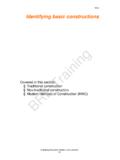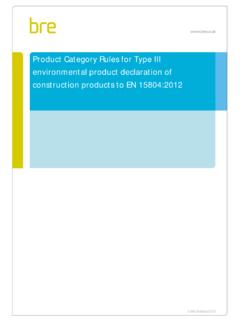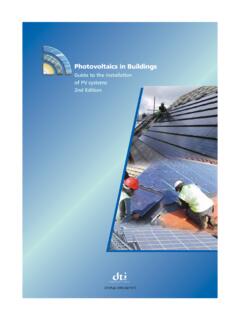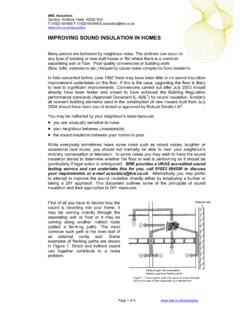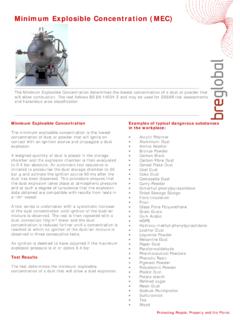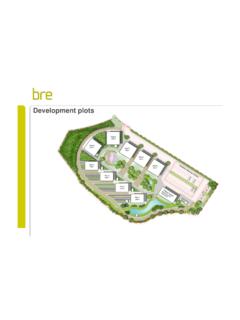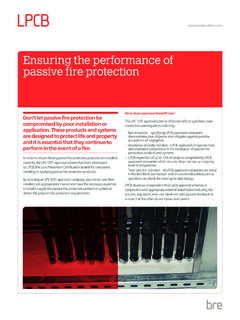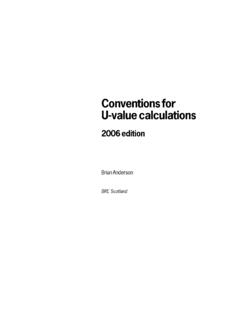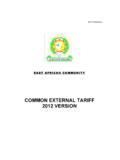Transcription of SAP 2012 The Government ˇs Standard Assessment …
1 SAP 2012 The Government s Standard Assessment Procedure for Energy Rating of Dwellings 2012 edition This document describes SAP 2012 version , dated October 2013. SAP assessors and other users should ensure that they are using the latest version of the document. Information on this and any updates will be published on the website below. Published on behalf of DECC by: BRE Garston, Watford, WD25 9XX Enquiries to Crown copyright 2014 rev February 2014 to include TER calculation for Wales rev June 2014 to include RdSAP 2012 Published on behalf of DECC by: BRE, Garston, Watford, WD25 9XX Crown copyright 2014 SAP 2012 version (October 2013) 1 Contents SUMMARY 5 INTRODUCTION 5 SCOPE OF THE SAP PROCEDURE 6 GENERAL PRINCIPLES 6 CALCULATION PROCEDURE AND CONVENTIONS 8 1 Dwelling dimensions 8 2 Ventilation rate 10 Chimneys and flues 10 Fans and passive vents 11 Pressurisation test 11 Draught lobby 11 Sheltered Sides 11 Mechanical ventilation 12 3 Heat transmission 14 U-values of opaque elements 14 Window U-values 15 U-values of elements adjacent to an unheated space 15 Thermal bridging 19 Dwellings that are part of larger premises 19 Curtain walling 19 Party walls 19 4 Domestic hot water 20 Distribution loss 20 Storage loss 20 Community schemes 21 Solar collector 21 Alternative DHW heating systems 21 5 Internal gains 22 6 Solar gains and utilisation factor 22 Solar gains for openings 22 Openings for which solar gain is included 22 More than one glazing type 23 Utilisation factor 23 Solar gain in summer 23 7 Mean internal temperature 23 Living area 23 8 Climatic data 23 9
2 Space heating requirement 23 Heating systems 24 Heating system efficiency (space and DHW) 24 Temperature of heat emitters for condensing boilers and heat pumps 27 Heating controls 28 10 Space cooling requirement 31 11 Fabric Energy Efficiency 31 12 Total energy use and fuel costs 32 Energy use 32 Fuel prices 32 Electricity tariff 32 SAP 2012 version (October 2013) 2 Main fuel types 33 Secondary fuel types 34 Water heating fuel types 34 Electricity for pumps and fans 35 Electricity for lighting 35 13 Energy cost rating 35 14 Carbon dioxide emissions and primary energy 35 15 Building regulations and dwelling emissions rate (DER) 36 16 CO2 emissions associated with appliances and cooking and site-wide electricity generation technologies 37 References 38 List of standards referred to in this document 38 Appendix A : Main and secondary heating systems 40 Appendix B : Gas and oil boiler systems, boilers with a thermal store, and range cooker boilers 44 Appendix C : Community heating, including schemes with Combined Heat and Power (CHP) and schemes that recover heat from power stations 47 Appendix D : Method of determining seasonal efficiency values for gas, oil and solid fuel boilers 51 Appendix E : Method of determining seasonal efficiency for gas, oil and solid fuel room heaters 63 Appendix F : Electric CPSUs 65 Appendix G : Flue gas heat recovery systems and Waste water heat recovery systems 66 Appendix H : Solar water heating 74 Appendix I (not used) 79 Appendix J (not used, see D6 for solid fuel boilers) 79 Appendix K : Thermal bridging 80 Appendix L : Energy for lighting and electrical appliances 83 Appendix M : Energy from Photovoltaic (PV) technology, small and micro wind turbines and small-scale hydro-electric generators 86 Appendix N : Micro-cogeneration (or micro-CHP) and heat pumps 90 Appendix O (not used) 101 Appendix P.
3 Assessment of internal temperature in summer 102 Appendix Q : Special features and specific data 107 Appendix R : Reference values 108 Appendix S : Reduced Data SAP for existing dwellings 113 Appendix T : Improvement measures for Energy Performance Certificates 162 Appendix U : Climate data 172 SAP WORKSHEET ( version ) 179 Table 1a: Number of days in month, nm 194 Table 1b: Occupancy and domestic hot water usage 194 Table 1c: Monthly factors for hot water use 194 Table 1d: Temperature rise of hot water drawn off (DTm, in K) 194 SAP 2012 version (October 2013) 3 Table 1e: Heat capacities for some common constructions 195 Table 1f: Thermal mass parameter 196 Table 2: Hot water storage loss factor 197 Table 2a: Volume factor for cylinders and storage combis 197 Table 2b: Factors applied to losses for cylinders, thermal stores and CPSUs, and to storage combi boilers not tested to EN 13203-2 or OPS 26 198 Table 3: Primary circuit loss 199 Table 3a: Additional losses for combi boilers not tested to EN 13203-2 or OPS 26 199 Table 3b: Losses for combi boilers tested to EN 13203-2 or OPS 26, schedule 2 only 200 Table 3c: Losses for combi boilers tested to EN 13203-2 or OPS 26, two schedules 201 Table 4a: Heating systems (space and water) 202 Table 4b: Seasonal efficiency for gas and oil boilers 207 Table 4c: Efficiency adjustments 208 Table 4d: Heating type and responsiveness for wet systems depending on heat emitter 209 Table 4e: Heating system controls 210 Table 4f: Electricity for fans and pumps and electric keep-hot facility 213 Table 4g: Default specific fan power for mechanical ventilation systems and heat recovery efficiency for MVHR systems 214 Table 4h: In-use factors for mechanical ventilation systems 214 Table 5: Internal heat gains 215 Table 5a: Gains from pumps and fans 215 Table 6b: Transmittance factors for glazing 216 Table 6c: Frame factors for windows and glazed doors 216 Table 6d.
4 Solar and light access factors 216 Table 6e: Default U-values (W/m2K) for windows, doors and roof windows 217 Table 9: Heating periods and heating temperatures 219 Table 9a: Utilisation factor for heating 219 Table 9b: Temperature reduction when heating is off 220 Table 9c: Heating requirement 220 Table 10a: Utilisation factor for cooling 222 Table 10b: Cooling requirement 222 Table 10c: Energy Efficiency Ratio (EER) and System Energy Efficiency Ratio (SEER) 223 Table 11: Fraction of heat supplied by secondary heating systems 224 Table 12: Fuel prices, emission factors and primary energy factors 225 Table 12a: High-rate fractions for systems using 7-hour and 10-hour tariffs 227 Table 12b: Solid Fuels 228 Table 12c: Distribution loss factor for group and community heating schemes 229 Table 13: High-rate fraction for electric DHW heating 230 Table 14: Rating bands 231 Table 15: Relationship between SAP 2009 ratings and SAP 2012 ratings 231 SAP 2012 version (October 2013) 4 Table 16: Relationship between Environmental Impact ratings, SAP 2009 and SAP 2012 232 SAP 2012 version (October 2013) 5 SUMMARY This manual describes the Government s Standard Assessment Procedure (SAP) for assessing the energy performance of dwellings.
5 The indicators of energy performance are Fabric Energy Efficiency (FEE), energy consumption per unit floor area, energy cost rating (the SAP rating), Environmental Impact rating based on CO2 emissions (the EI rating) and Dwelling CO2 Emission Rate (DER). The SAP rating is based on the energy costs associated with space heating, water heating, ventilation and lighting, less cost savings from energy generation technologies. It is adjusted for floor area so that it is essentially independent of dwelling size for a given built form. The SAP rating is expressed on a scale of 1 to 100, the higher the number the lower the running costs. The Environmental Impact rating is based on the annual CO2 emissions associated with space heating, water heating, ventilation and lighting, less the emissions saved by energy generation technologies. It is adjusted for floor area so that it is essentially independent of dwelling size for a given built form. The Environmental Impact rating is expressed on a scale of 1 to 100, the higher the number the better the Standard .
6 The Dwelling CO2 Emission Rate is a similar indicator to the Environmental Impact rating, which is used for the purposes of compliance with building regulations. It is equal to the annual CO2 emissions per unit floor area for space heating, water heating, ventilation and lighting, less the emissions saved by energy generation technologies, expressed in kg/m /year. The method of calculating the energy performance and the ratings is set out in the form of a worksheet, accompanied by a series of tables. The methodology is compliant with the Energy Performance of Buildings Directive. The calculation should be carried out using a computer program that implements the worksheet and is approved for SAP calculations (BRE approves SAP software used within schemes recognised by Government on behalf of the Department for Energy and Climate Change, the Department for Communities and Local Government , the Scottish Government , the Welsh Government , and the Department of Finance and Personnel). INTRODUCTION The Standard Assessment Procedure (SAP) is adopted by Government as the UK methodology for calculating the energy performance of dwellings.
7 The calculation is based on the energy balance taking into account a range of factors that contribute to energy efficiency: materials used for construction of the dwelling thermal insulation of the building fabric air leakage ventilation characteristics of the dwelling, and ventilation equipment efficiency and control of the heating system(s) solar gains through openings of the dwelling the fuel used to provide space and water heating, ventilation and lighting energy for space cooling, if applicable renewable energy technologies The calculation is independent of factors related to the individual characteristics of the household occupying the dwelling when the rating is calculated, for example: household size and composition; ownership and efficiency of particular domestic electrical appliances; individual heating patterns and temperatures. The procedure used for the calculation is based on the BRE Domestic Energy Model (BREDEM[ 1,2,3,4,5]), which provides a framework for the calculation of energy use in dwellings.
8 The procedure is consistent with the Standard BS EN ISO 13790. SAP 2012 version (October 2013) 6 The Standard Assessment Procedure was first published by the then DOE and BRE in 1993 and in amended form in 1994, and conventions to be used with it were published in 1996 and amended in 1997. Revised versions were published in 1998, 2001, 2005 and 2009. The present edition is SAP 2012 in which: - climatic data has been extended to allow calculations using regional weather - an allowance for height above sea level is incorporated into external temperature data - CO2 emission factors have been extensively revised - fuel price and primary energy factors have been revised - the options for heat losses from primary pipework have been extended At present the effect of feed-in tariffs has not been factored into SAP. This is under consideration and the Government will consult on proposals. SCOPE OF THE SAP PROCEDURE The procedure is applicable to self-contained dwellings (of any size and any age).
9 For flats, it applies to the individual flat and does not include common areas such as access corridors. Note: common areas of blocks of flats such as heated access corridors, and other buildings (even though used for residential purposes, nursing homes) are assessed using procedures for non-domestic buildings. Where part of an accommodation unit is used for commercial purposes ( as an office or shop), this part should be included as part of the dwelling if the commercial part could revert to domestic use on a change of occupancy. That would be applicable where: - there is direct access between the commercial part and the remainder of the accommodation, and - all is contained within the same thermal envelope, and - the living accommodation occupies a substantial proportion of the whole accommodation unit. Where a self-contained dwelling is part of a substantially larger building, and the remainder of the building would not be expected to revert to domestic use, the dwelling is assessed by SAP and the remainder by procedures for non-domestic buildings.
10 SAP is a methodology for calculating energy use and the associated running costs and CO2 emissions. It does not set any standards or limitations on data. For SAP calculations dwellings have a Standard occupancy and usage pattern, which are typical values of quantities that in practice vary substantially between dwellings of similar size and type. The occupancy assumed for SAP calculations is not suitable for design purposes, for example of hot water systems. GENERAL PRINCIPLES Input precision and rounding Data should be entered into calculation software as accurately as possible, although it is unnecessary to go beyond 3 significant figures (and some product data may only be available to lesser precision). Input data Various tables of performance data are provided as part of this document. The tables are used when specific performance information on the product or system is not available. However, when specific performance information is available for the following items, it should be used in preference to data from the tables, particularly in the new build context.
